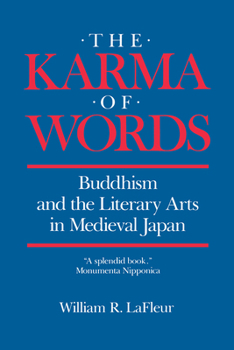The Karma of Words: Buddhism and the Literary Arts in Medieval Japan
Select Format
Select Condition 
Book Overview
"A masterly book . . . will prove of great assistance to a student of Japanese literature and thought from the eleventh century onwards." -- Times Literary Supplement "A major contribution to the fields of Japanese studies, comparative literature, and history of religions . . . a book that begs for classroom use." -- The Eastern Buddhist "Innovative and provocative . . . will be of interest not only to specialists in Japanese religion and Japanese culture, but also to literary critics and cultural historians." -- Religious Studies Review "Rich and stimulating material . . . an important help and influence to all concerned with understanding the tradition that has shaped Japanese culture and religion." -- History of Religions "Thought provoking, finely written . . . one of the more original and creative contributions to the study of medieval culture and religion to be produced by a Western scholar. . . . Can be read with profit by all Western students of Japanese culture . . . one of those rare books that has something to offer Japanese specialists in medieval studies." -- Journal of Japanese Studies "A very important contribution to Japanese studies . . . a paradigm of the genre." -- Pacific Affairs "This is an exciting, ground-breaking book." -- Chanoyu Quarterly "I have been most impressed and even excited by what I have read." --Donald Keene, Professor Emeritus and Shincho Professor Emeritus of Japanese Literature at Columbia University "This is one of the most important books in Japanese studies in a long time and will influence the entire field." --Robert Bellah, former Elliott Professor of Sociology, Professor Emeritus at the University of California, Berkeley
Format:Paperback
Language:English
ISBN:0520056221
ISBN13:9780520056220
Release Date:May 1986
Publisher:University of California Press
Length:232 Pages
Weight:0.55 lbs.
Dimensions:0.6" x 6.3" x 9.0"
Customer Reviews
2 ratings
A stunning work, worth the hassle
Published by Thriftbooks.com User , 22 years ago
This is a truly amazing study. I read it for a class I was taking on medieval Japan. The professor warned that this book was very dense and difficult to read, but I thought - No problem! It's under 200 pages, I'm a fast reader, I like the subject.So let me restate: this book is a DENSE read. Every sentence has deep significance, and don't be surprised if you have to reread paragraphs several times, even if you're used to memorizing things with a once-over.That said, this book was so good that it gets 5 stars despite the difficulty of reading it. LaFleur deftly weaves together strands from medieval forms of Japanese Buddhism (specifically Tendai and Shingon) during the Kamakura and Ashikaga bakufus with earlier cultural tendencies from Heian times right through to the flowering of new cultural ideas in Tokugawa Japan. He does not shy away from appreciating art or fine points of theology on their own terms, but also does not hesitate to show how the two blended together and shaped one another.I personally enjoyed the sections on the Hojo-Ki by Chomei more than his sections on No and Kyogen, but that's personal preference. You will also gain a new understanding of major poets and monks of the era, such as Chomei, Basho, and Zeami. Rather than try and define such difficult concepts as yugen, he illustrates them through use of those individuals and their own efforts at definitions.Read a chapter at a time or all at once, a great book.
Great
Published by Thriftbooks.com User , 26 years ago
This book is good for both those with casual interest in Japanese culture and specific interests in the field of Buddhism. Special attention is paid to the relationship between religion and the traditional theatre forms of Noh and Kyogen.





